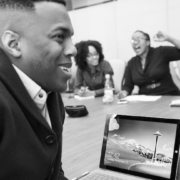How to Make a Positive (and Provocative) First Impression
We all know that feeling of walking into a room in which we know absolutely nobody. You might think everyone is staring at you, and that could be true. In fact, they’re already forming opinions about you based on your posture, demeanor, attire, and overall appearance. That can be a harsh reality to face, especially if you’re looking back at a conference room full of expressionless members of the board of directors.
The same thing happens in networking situations, which is why you should enter a room of strangers with a minimum/maximum mindset. Develop a range of goals, which will help you survive in uncomfortable situations. For example, during a social function at an industry trade show, don’t set expectations so high (drumming up new business with everyone you meet) that you’re bound to wind up disappointed. Instead, determine that your minimum objective will be, say, to leave with at least one solid lead for a new client, while your maximum objective could be to set up a personal meeting or teleconference to hammer out details of the new business you just acquired.
To get to that point, though, you must exude confidence. So be prepared by researching your targets, developing three intriguing questions for any new person you meet — Where are you from? How did you land in your current position? What’s your take on the new industry regulations? — and then be genuinely interested in what they say. In turn, your targets will take an interest in you and your business. Think of this counterintuitively: When they are talking, you are making a good impression.
While what you have to say and how you say it can trump the fact that you might have a pumpernickel seed stuck between your front teeth after that morning bagel, it still pays to practice sartorial persuasion. In other words, dress well. In most business situations, that means your attire when visiting an organization’s headquarters should be 10 percent more professional than what employees typically wear there to work every day. If the men dress in polo shirts and button-downs, you should wear a sport coat without a tie. If the women wear skirts and blouses, you do the same and add a blazer with a bit of jewelry. If you don’t know what the office attire is, better to err on the side of caution. Same goes for trade shows and industry gatherings.
Would you rather be overdressed or underdressed? Do you want people to think that you give your appearance thoughtful consideration? You better, because if you’re reliable in your attire, people will presume you’re also a likeable and trustworthy person to whom they can (and should) say “yes.” Remember the halo effect?












Leave a Reply
Want to join the discussion?Feel free to contribute!